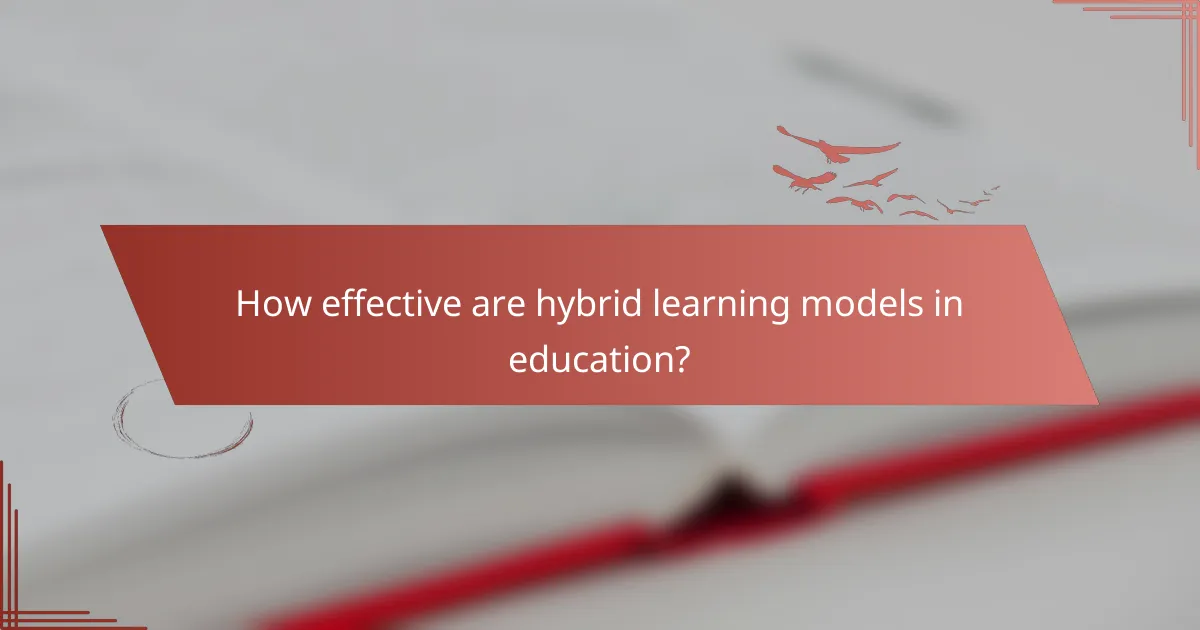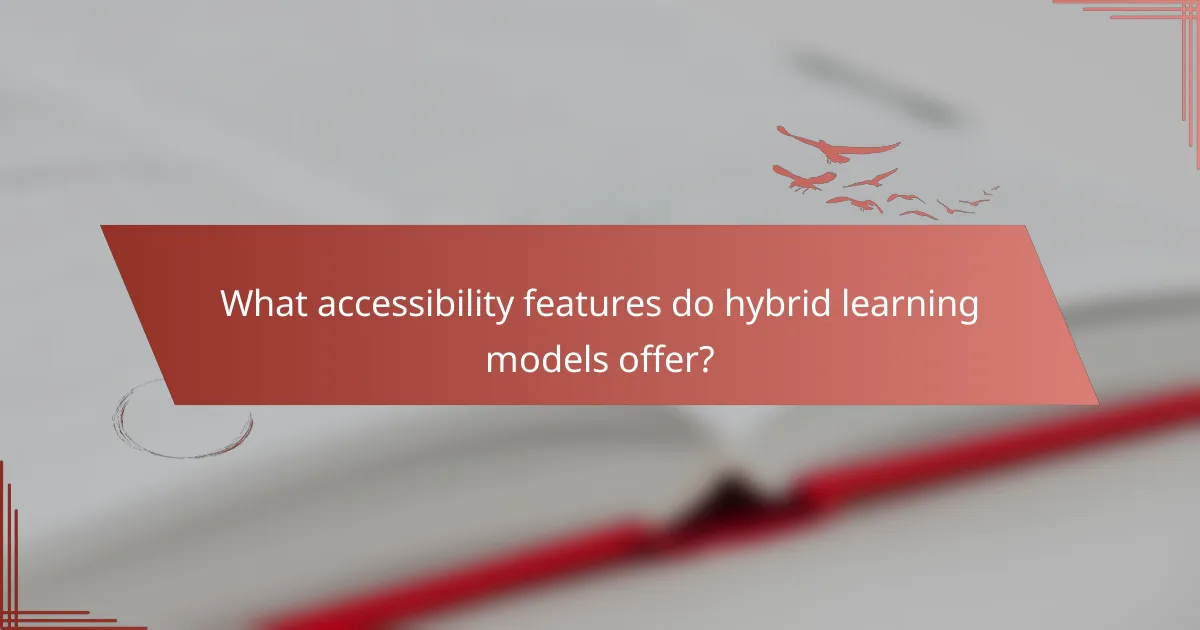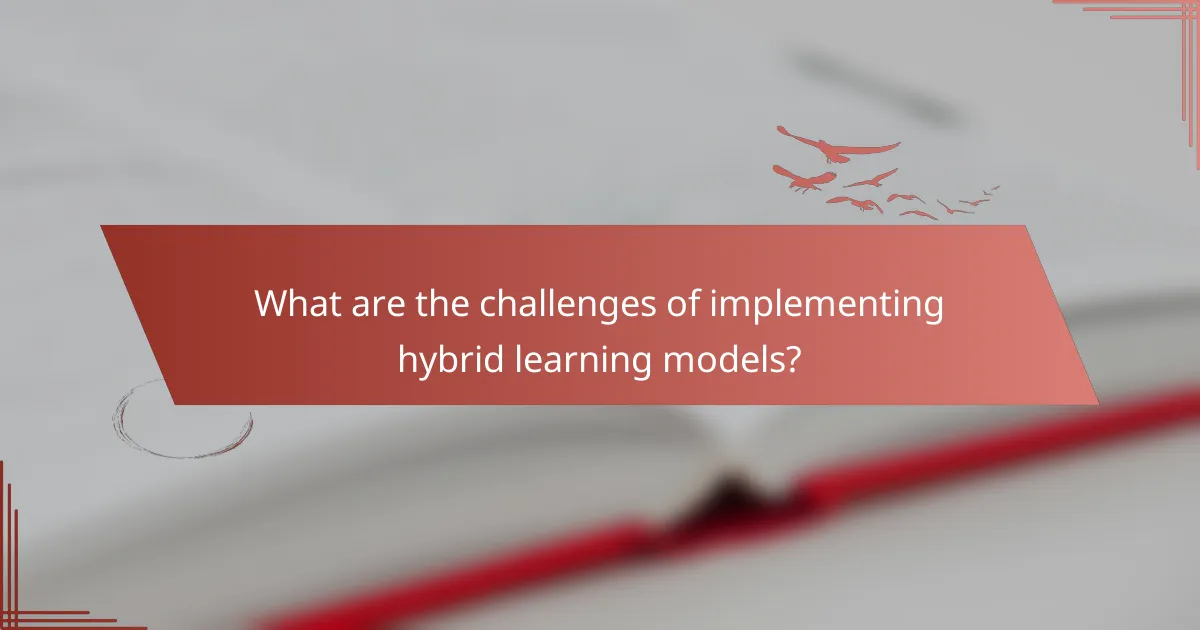Hybrid learning models integrate in-person and online instruction, providing a flexible and accessible educational framework. By combining traditional classroom experiences with digital resources, these models enhance student engagement and cater to diverse learning styles, ultimately fostering a more interactive and personalized learning environment.

How effective are hybrid learning models in education?
Hybrid learning models combine in-person and online instruction, offering flexibility and accessibility. Their effectiveness often hinges on how well they engage students and support diverse learning styles.
Increased student performance
Hybrid learning can lead to improved student performance by catering to individual learning preferences. For instance, students who struggle with traditional classroom settings may thrive in a hybrid environment that allows for self-paced online work alongside face-to-face interactions.
Research indicates that when students have the opportunity to learn in varied formats, their understanding and application of material can increase, often resulting in higher grades and test scores.
Enhanced retention rates
Retention rates tend to improve in hybrid learning models due to the combination of different instructional methods. Engaging students through multimedia resources and interactive online platforms can reinforce learning and help solidify knowledge.
For example, students who participate in discussions both online and in-person are more likely to remember key concepts, as they encounter the material in multiple contexts.
Flexible learning environments
Hybrid learning models create flexible environments that accommodate different schedules and learning styles. Students can choose when and where to engage with course materials, which can lead to increased motivation and satisfaction.
Educators should consider incorporating tools like learning management systems (LMS) to facilitate this flexibility, allowing students to access resources anytime. However, it’s essential to ensure that all students have reliable internet access and the necessary technology to participate fully.

What are the key components of hybrid learning models?
Hybrid learning models combine online and in-person education to enhance student engagement and accessibility. Key components include the integration of digital resources with traditional classroom settings, personalized learning pathways, and effective technology utilization.
Online and in-person integration
Online and in-person integration is essential for hybrid learning, as it allows students to benefit from both environments. This approach typically involves alternating between virtual classes and face-to-face sessions, which can enhance understanding and retention of material.
For example, a course might include online lectures followed by in-person discussions or labs. This blend can cater to different learning styles, making education more inclusive and effective.
Personalized learning pathways
Personalized learning pathways enable students to learn at their own pace and according to their individual needs. In a hybrid model, educators can tailor assignments and resources based on each student’s progress and preferences, fostering a more engaging learning experience.
For instance, students might choose from various online modules that align with their interests, while still participating in mandatory in-person activities. This flexibility can improve motivation and outcomes, particularly for diverse learner groups.
Technology utilization
Effective technology utilization is crucial in hybrid learning models, as it supports both online and in-person components. Tools such as learning management systems (LMS), video conferencing software, and interactive platforms facilitate seamless communication and resource sharing.
Educators should ensure that all students have access to necessary technology and training. Common pitfalls include assuming all students are equally tech-savvy or neglecting to provide adequate support for online tools, which can hinder engagement and learning effectiveness.

How do hybrid learning models improve student engagement?
Hybrid learning models enhance student engagement by combining in-person and online elements, allowing for a more flexible and interactive educational experience. This approach caters to diverse learning styles and preferences, making it easier for students to participate actively in their education.
Interactive learning experiences
Interactive learning experiences in hybrid models often utilize technology to create dynamic lessons that encourage student participation. Tools such as virtual simulations, interactive quizzes, and multimedia presentations can make learning more engaging and memorable. For instance, using platforms like Kahoot! or Nearpod can transform a traditional lecture into an interactive session.
Incorporating gamification elements, such as points or badges for participation, can further motivate students to engage with the material. This approach not only captures attention but also fosters a sense of achievement and competition among peers.
Collaborative projects
Collaborative projects are a cornerstone of hybrid learning, allowing students to work together both in-person and online. These projects can take various forms, such as group presentations, research assignments, or creative tasks that require teamwork. Utilizing tools like Google Workspace or Microsoft Teams facilitates seamless collaboration, enabling students to contribute regardless of their location.
When assigning collaborative projects, it’s essential to define clear roles and responsibilities to ensure all participants are engaged. Regular check-ins and feedback sessions can help maintain momentum and accountability among group members.
Real-time feedback mechanisms
Real-time feedback mechanisms are crucial in hybrid learning environments, as they allow educators to gauge student understanding and engagement instantly. Tools like live polls, quizzes, and discussion boards enable teachers to assess comprehension and adjust instruction accordingly. This immediate feedback loop helps students identify areas for improvement and encourages them to take an active role in their learning journey.
Incorporating regular feedback sessions, whether through digital platforms or face-to-face interactions, fosters a culture of open communication. This practice not only enhances student engagement but also builds trust between educators and learners, creating a supportive learning atmosphere.

What accessibility features do hybrid learning models offer?
Hybrid learning models provide various accessibility features designed to accommodate different learning needs. These features enhance engagement and ensure that all students can participate effectively, regardless of their circumstances.
Accommodations for diverse learners
Hybrid learning environments often include accommodations tailored for diverse learners, such as those with disabilities or language barriers. For instance, platforms may offer screen readers, captioning services, and multilingual support to facilitate understanding.
Additionally, teachers can provide differentiated instruction and personalized learning paths, allowing students to progress at their own pace. This flexibility helps address individual learning styles and needs, promoting inclusivity.
Remote access to resources
One of the key features of hybrid learning is the ability to access educational resources remotely. Students can utilize online libraries, databases, and interactive tools from anywhere, breaking down geographical barriers.
Moreover, many institutions provide digital platforms that house course materials, enabling students to revisit lectures and assignments at their convenience. This access ensures that learners can engage with content on their own terms, which can enhance comprehension and retention.
Flexible scheduling options
Flexible scheduling is a significant advantage of hybrid learning models, allowing students to choose when and how they participate in classes. This flexibility can accommodate various personal commitments, such as work or family responsibilities.
For example, some programs may offer asynchronous classes, where students can complete coursework on their own schedule, while others might provide live sessions at different times. This adaptability can lead to higher engagement and satisfaction among learners, as they can tailor their education to fit their lifestyles.

What are the challenges of implementing hybrid learning models?
Implementing hybrid learning models presents several challenges, including disparities in technology access, the need for instructor training, and issues related to student motivation. Each of these factors can significantly impact the effectiveness and engagement levels within hybrid educational environments.
Technology access disparities
Technology access disparities refer to the unequal availability of devices and internet connectivity among students. In many regions, particularly in rural or low-income areas, students may lack reliable access to the necessary technology, hindering their ability to participate fully in hybrid learning.
To address these disparities, schools and institutions can explore partnerships with local organizations to provide devices or subsidize internet costs. Additionally, offering offline resources can help bridge the gap for students with limited connectivity.
Instructor training requirements
Effective hybrid learning requires instructors to be well-trained in both online and in-person teaching methods. Many educators may not have received formal training in using digital tools or managing a blended classroom, which can lead to inconsistent teaching quality.
To overcome this challenge, institutions should invest in comprehensive professional development programs that focus on hybrid teaching strategies, technology integration, and student engagement techniques. Regular workshops and peer collaboration can also enhance instructors’ skills and confidence.
Student motivation issues
Student motivation can be a significant hurdle in hybrid learning environments, as the flexibility of online components may lead to disengagement. Without the structure of traditional classrooms, some students may struggle to stay focused and committed to their studies.
To foster motivation, educators can implement strategies such as setting clear expectations, providing regular feedback, and incorporating interactive elements into lessons. Creating a sense of community through group projects or discussion forums can also help keep students engaged and accountable.

How do hybrid learning models compare to traditional models?
Hybrid learning models combine in-person and online instruction, offering flexibility that traditional models may lack. This approach can enhance accessibility and engagement, but its effectiveness varies based on implementation and context.
Cost-effectiveness analysis
Hybrid learning models can be more cost-effective than traditional models, particularly for institutions that can reduce physical space requirements and associated overhead costs. By leveraging online resources, schools may save on materials and infrastructure while still providing quality education.
However, initial investments in technology and training for educators are necessary. Institutions should evaluate long-term savings against these upfront costs to determine overall financial viability.
Learning outcomes comparison
Research indicates that learning outcomes in hybrid models can be comparable to traditional methods, depending on the design and delivery of the curriculum. Effective hybrid programs often utilize a mix of synchronous and asynchronous learning, catering to diverse learning styles.
Students who thrive in self-directed environments may perform particularly well in hybrid settings. Conversely, those who benefit from direct interaction may find traditional models more effective. Continuous assessment and adaptation are crucial for optimizing learning outcomes.
Student satisfaction surveys
Student satisfaction with hybrid learning models tends to be mixed, with many appreciating the flexibility but others missing the social aspects of traditional classrooms. Surveys often reveal that students value the ability to learn at their own pace while also expressing a desire for more face-to-face interaction.
Institutions should regularly gather feedback to understand student preferences and make necessary adjustments. Engaging students in the design of hybrid programs can enhance satisfaction and overall effectiveness.
